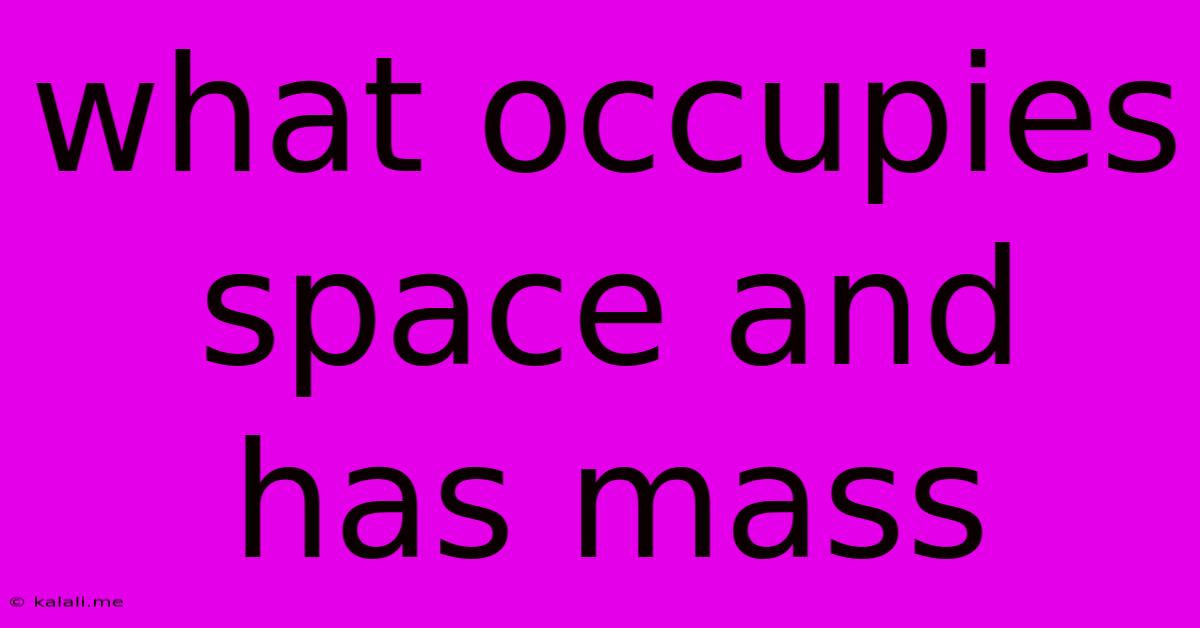What Occupies Space And Has Mass
Kalali
Jun 14, 2025 · 3 min read

Table of Contents
What Occupies Space and Has Mass? Understanding Matter
What occupies space and has mass? The simple answer is matter. Everything you can see, touch, and even many things you can't, are made of matter. This article will delve deeper into the concept of matter, exploring its properties, states, and the fundamental particles that compose it. Understanding matter is fundamental to understanding the universe around us.
Matter is defined by its two key properties: it occupies space (it has volume) and it has mass. Mass is a measure of the amount of matter in an object, often confused with weight, which is the force of gravity acting on that mass. Let's break down these properties further:
Occupying Space (Volume)
Think about filling a glass with water. The water takes up space within the glass; it has volume. Similarly, a rock, a cloud, and even the air around you all occupy space. The amount of space an object occupies determines its volume, which can be measured in various units like cubic centimeters or liters. This applies to solids, liquids, and gases – all forms of matter.
Possessing Mass (Inertia)
Mass is a more fundamental property. It represents resistance to acceleration or a change in motion. This resistance is known as inertia. The more massive an object is, the harder it is to change its velocity. A bowling ball, for instance, is harder to push across a floor than a tennis ball because it has a significantly greater mass. This is why mass is often considered a measure of an object's inertia.
The States of Matter
Matter exists in various states or phases, each with different characteristics:
- Solid: Solids have a definite shape and volume. The particles in a solid are tightly packed together and vibrate in fixed positions. Examples include ice, wood, and rocks.
- Liquid: Liquids have a definite volume but take the shape of their container. The particles in a liquid are closer together than in a gas but can move around more freely than in a solid. Examples include water, oil, and mercury.
- Gas: Gases have neither a definite shape nor volume; they expand to fill their container. The particles in a gas are widely spaced and move randomly. Examples include air, oxygen, and carbon dioxide.
- Plasma: Plasma is often considered the fourth state of matter. It is an ionized gas, meaning the electrons have been stripped from the atoms, creating a mixture of ions and free electrons. Plasma is found in stars and lightning.
The Building Blocks of Matter: Atoms and Molecules
At a fundamental level, matter is composed of atoms, which are the smallest units of an element that retain the chemical properties of that element. Atoms themselves consist of even smaller particles: protons, neutrons, and electrons. Protons and neutrons reside in the atom's nucleus, while electrons orbit the nucleus.
Atoms can combine to form molecules, which are groups of two or more atoms held together by chemical bonds. Water (H₂O), for example, is a molecule composed of two hydrogen atoms and one oxygen atom. The vast majority of substances we encounter in everyday life are composed of molecules.
Beyond the Basics: Dark Matter and Dark Energy
It's important to note that while this article focuses on the readily observable matter, the universe contains other forms of matter that are much more mysterious. These include dark matter and dark energy, which are believed to make up a significant portion of the universe's mass-energy content, but their nature remains largely unknown. Their existence is inferred from their gravitational effects on observable matter.
In conclusion, matter is anything that occupies space and has mass. Understanding its properties, states, and fundamental building blocks is crucial to understanding the physical world around us and the universe as a whole. This includes not only the readily observable matter but also the enigmatic dark matter and energy that constitute a significant part of the cosmic inventory.
Latest Posts
Latest Posts
-
The Ion Essential For Blood Clotting Is
Jun 14, 2025
-
The Power Factor Of Pure Resistive Circuit Is
Jun 14, 2025
-
What Are The Prime Factorization Of 63
Jun 14, 2025
-
Which Group Is The Most Reactive
Jun 14, 2025
-
What Is The Lcm Of 18 And 20
Jun 14, 2025
Related Post
Thank you for visiting our website which covers about What Occupies Space And Has Mass . We hope the information provided has been useful to you. Feel free to contact us if you have any questions or need further assistance. See you next time and don't miss to bookmark.